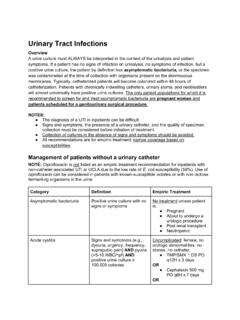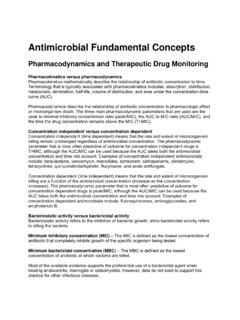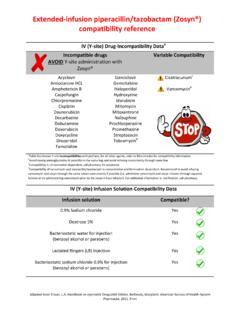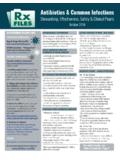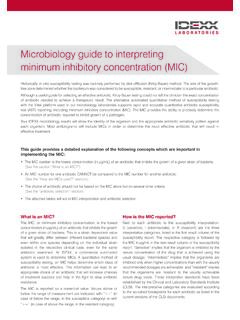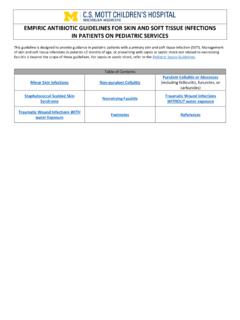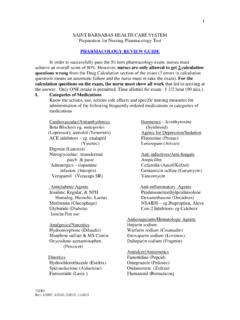Transcription of Skin and Soft Tissue Infections - University of California ...
1 Skin and Soft Tissue Infections Cellulitis Note: The most common etiology of cellulitis with purulent drainage is S. aureus, although Group A streptococci and other streptococcal species can also present in this manner. TREATMENT The following regimens include coverage for MSSA, community-acquired MRSA (CA-MRSA), and streptococci. Coverage for gram negative organisms is not needed except in very specific patient populations (outlined below). Oral Regimens Doxycycline 100 mg PO BID PLUS Cephalexin 500 mg PO QID OR Amoxicillin 500 mg PO TID OR TMP/SMX 1-2 DS tab PO BID PLUS Amoxicillin 500 mg PO TID* OR Clindamycin 300 mg PO TID *TMP/SMX and doxycycline have poor activity against Group A streptococci and should be combined with Amoxicillin or Cephalexin.
2 Parenteral Regimens Vancomycin (moderate to severe disease or nosocomial acquisition) OR Clindamycin 600 mg IV q8h (mild disease) Duration: 7-10 days. May step down to oral therapy when patient is improving. Type of Infection Suspected Organisms Recommended Treatment Folliculitis S. aureus, P aeruginosa (hot tub) - Warm compresses - No antibiotics Furuncles, carbuncles, boils S. aureus, including CA-MRSA - I&D - If fever and/or surrounding cellulitis, see oral regimens above Abscesses S. aureus, including CA-MRSA I&D - If surrounding cellulitis, systemic symptoms, and/or multiple lesions, see oral regimens above - If gangrene, immunocompromised, extensive surrounding cellulitis, or severe systemic symptoms: -Consider surgical treatment -Vancomycin Impetigo S.
3 Aureus, including CA-MRSA, S. pyogenes - Warm water soak - Oral therapy (see regimens above) Erysipelas (characterized by lesions that are raised above the level of surrounding skin, with a clear demarcation between involved and uninvolved Tissue ) S. pyogenes, rarely S. aureus, or S. agalactiae - PCN VK 250-500 mg PO QID - Clindamycin 300 mg PO/600 mg IV TID - If MRSA, add TMP/SMX DS BID Cellulitis S. aureus, including CA-MRSA, S. pyogenes Diabetics: mixed anaerobic and aerobic flora. Consider gram-negative organisms in immunocompromised hosts or refractory patients.
4 Consider anaerobes and fungi in IVDU Mild: see oral regimens above Moderate / severe: see parenteral regimens above Mild: [Amoxicillin/clavulante 875 mg PO BID OR Ciprofloxacin 500 mg PO BID] PLUS Clindamycin 300 mg PO TID -Piperacillin/tazobactam g IV q6h OR Meropenem 500 mg IV q8h. If concern for MRSA, add vancomycin Moderate-severe -Severe PCN allergy: Ciprofloxacin + Clindamycin OR Aztreonam + Clindamycin. If concern for MRSA, use vancomycin instead of clindamycin and add anaerobic coverage with metronidazole.
5 TREATMENT NOTES Microbiology S. aureus and Streptococci (especially Group A) Rare causes of cellulitis are discussed below Management Always elevate the affected extremity. Treatment failure is more commonly due to failure to elevate than failure of antibiotics. Improvement of erythema can take days, especially in patients with venous stasis or lymphedema, because dead bacteria in the skin continue to induce inflammation. The microbiology laboratory routinely tests S. aureus isolates for inducible Clindamycin resistance and this testing is reflected in the reported susceptibility data.
6 If no culture data to guide therapy and high risk or suspicion of CA-MRSA or failure to improve on clindamycin, change clindamycin to alternate active agent such as bactrim or doxycycline. Resistance to fluoroquinolones in S. aureus is common and develops quickly. The vast majority of MRSA isolates are resistant to fluoroquinolones. Rifampin should NEVER be used as monotherapy because resistance develops rapidly. Therapy with fluoroquinolones for S. aureus Infections is not recommended. There is NO EVIDENCE that linezolid or daptomycin are superior to TMP/SMX, doxycycline, or clindamycin for the management of skin and soft Tissue Infections .
7 Linezolid or daptomycin should only be considered when the S. aureus isolate is resistant to other agents or the patient is intolerant of these agents. Elimination or prevention of interdigital tinea is important for cases of relapsing lower extremity cellulitis. Specialty referral should be considered in cases of lymphedema, refractory tinea pedis, chronic dermopathies, venous insufficiency, or post-surgical cellulitis. Other causes of cellulitis in select patient populations With bullae, vesicles, and ulcers after exposure to seawater or raw oysters, consider Vibrio vulnificus, especially in patients with chronic liver disease.
8 Rare, but rapidly fatal if untreated. Treat with ceftriaxone 1 g IV q24h PLUS doxycycline 100 mg PO BID. Neutropenic, solid organ transplant, and cirrhotic patients may have cellulitis due to gram-negative organisms. Consider expanding coverage in these cases. Gram-negative cellulitis is exceedingly rare in other patient populations and routine gram-negative coverage is unnecessary. If an eschar is present, consider angioinvasive organisms (Pseudomonas, aspergillosis, mold). Infectious Diseases consult is advised. Animal and human bites: Pasteurella multocida should be covered for cat and dog bites.
9 Treat with Amoxicillin/clavulanate 875 mg PO BID OR Ampicillin/sulbactam g IV q6h. If PCN allergy: Ciprofloxacin 500 mg PO / 400 mg IV q24h PLUS Clindamycin 300 mg PO TID/600 mg IV q8h. Remember to consider tetanus booster and/or rabies vaccination. Cutaneous Abscess Incision and drainage (I&D) is the primary treatment for a cutaneous abscess. Lesions that appear superficial can often have associated abscess formation that is not clearly appreciated without debridement of the wound or, on occasion, additional imaging.
10 At the time of I&D, a sample should be obtained for culture and sensitivity testing. A superficial wound swab of purulent drainage prior to I&D is of limited utility. Antibiotics are an adjunct to I&D in the management of uncomplicated skin abscesses caused by CA-MRSA. Indications for antimicrobial therapy in patients with cutaneous abscesses Severe or rapidly progressive Infections : The presence of extensive associated cellulitis Signs and symptoms of systemic illness Diabetes or other immune suppression ( , solid organ transplant) Advanced age Location of the abscess in an area where complete drainage is difficult Lack of response to I&D alone.
